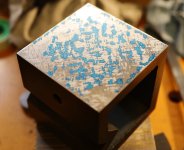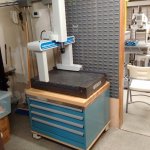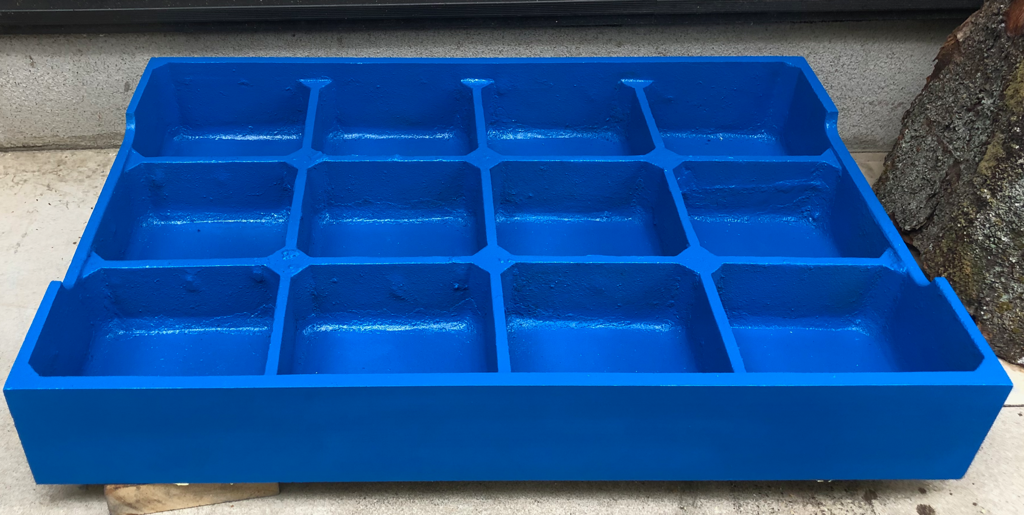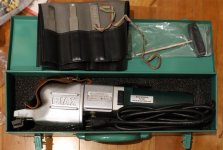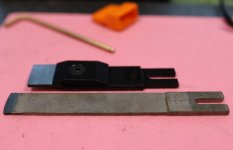Reviving this thread, because today was the day I first tried my hand at power scraping.
I started off with the
Junker Biax as even though it didn't have its new power switch, I expected to be still functional. I wanted to see how everything would hold up, and discovered that I will need to make an adjustment to the travel setting bolt. I'll detail that in its existing thread once I get to it, likely when the power switch gets replaced.
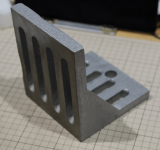
I had originally intended to start with a cast iron angle plate I had previously cleaned up. But I realized that all the slots it had would make for a very complex surface to try and scrape, and so I chose a more vulnerable victim. Japanese use a lot of
Mass Blocks which are (usually) cast iron cubes with two open sides and a pair of V grooves on the top and a little removable clamping arm.
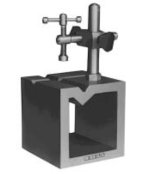
They are very common here, and often sold rather cheaply, even the 'precision' ones that are hand scraped and very accurate can be quite inexpensive on the used market. I picked up a couple different sizes over time, as they come in handy, and having a cheap piece of cast iron to make something out of can be handy sometimes. I also figured they'd be good scraping practice.
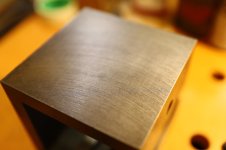
So this is a Uni Seiki B-grade milled finish, 100mm block. Even these low grade blocks are still quite accurate, this one came from the factory with a specification of under 20 microns of deviation for squareness and parallelism according to them. I haven't given it the full restoration treatment yet, a deep cleaning and repaint, but it may make sense if the scraping is successful. I started with the side of the block instead of the base, since if this goes badly it will still be mostly intact.
I set the old Biax to about a 12mm stroke and speed setting 2, and used the 170mm rigid style replaceable carbide tool with a 25mm wide ~90mm radius blade that came with it and looked reasonably sharp. This was used to rough in the surface and clear up some of the deep milling marks. It went pretty well, but clamping the block to my DIY MFT table was kind of a pain to keep reorienting it, so I switched to using the magnetic chuck which helped ease the manipulation quite a bit. After a short time things started going a bit wonky, the Biax seemed harder to manage and more prone to chatter and I was seeing a lot of chicken scratches (dull blade?) I double checked it, and the stroke had run out to maximum as the adjustment bolt was now too loose after I reassembled it. It was a good time to swap over to the other machine for comparison purposes. I used the same blade, just to confirm the behaviour between the two machines was similar, than after a few passes installed a factory 'spring' type 20mm x 60mm diameter blade.

The first prints showed just a few points of contact on the corners. The little old surface plate I'm using as the master hasn't actually been thoroughly inspected for flatness, it's certainly well used but the factory scraping is mostly intact and I figured it would work well enough for the roughing. I have a brand new granite plate, but it is too heavy to move close to the work and I didn't want to do a lot of back and forth for this experiment. I confirmed the block was indeed concave with a little knife edge, so the plate was likely telling the truth and proceeded to work on the corners and two edges. I'm pretty sure I should have continued to do roughing passes at this point, but I made the rookie mistake of chasing the spotting too early, I'm lucky this was such a small area and that the corners were not that high.
A couple of things I want to note as a newbie, for fellow first timers reading this thread. The people who say that the spring style of blade is easier to use (for beginners anyway) seem to be spot on. I found it a lot easier to zero in on the correct angle of attack for the blade to make a proper scrape, and if I came in
too hot (too steep of an angle) the Biax blade would flex a bit rather than chatter like the rigid ones, so overall it was a lot more forgiving I think. I ended up with two home built rigid blades of the same length, and at least one will get thinned down to hopefully add some flex to it.
The second observation is that starting off it would seem that there is shockingly little contact area. I used a pretty thin layer of spotting ink, but even when I intentionally overloaded it, it took a long time before I started to get anything more than 3-5 really small contact points. Not sure if this was just this piece, or a typical experience, but I wasn't really prepared for how long it took before the contact started spreading out and giving coverage.
The third thing is that initially I was letting the tool do the work, I held it firmly against my body as recommended, but was letting its own mass act as the counter to the scraping forces. Later on I started physically compensating, pushing back against the cuts, and it seemed like there was a lot less chatter and a cleaner cut. I need a lot more time on the machine to know if this is the right action, but this is one of the things I clearly need to pay attention to. Oh, and after a few hours your arms are going to get tired. I didn't work that hard or that long, but I can feel it more than I expected to.
Okay, so I'm not going to ask for a grade or anything cringe like that, but I'll post the current state of the surface since this is all about learning, and sharing my progress is important. I used an extra thick indicator layer to help make the photo pop, there are some obvious 'apprentice' gouges from me trying to experiment with the blade angle with the rigid holder when the machine was inadvertently using its full stroke

The base pattern could be a lot more symmetrical and orderly, and I'm pretty sure the scratches are from dull or chipped blades, but a freshly sharpened blade will clarify that. Maybe just my lack of skill. I quit a little early tonight because I need to hone these blades to verify if that's impacting the scrape quality or if it is something else, and that's outside work on the carbide grinder, so I'll try to finish this surface tomorrow.
